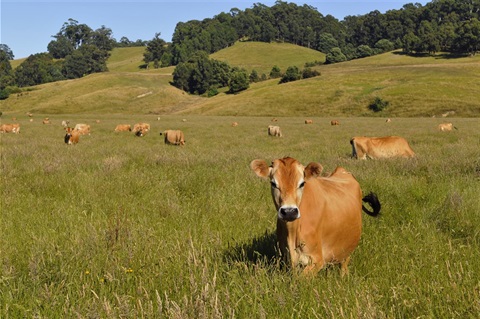Council recognises the importance of protecting farm land
Published on 14 August 2018

Council report recognises the importance of protecting agricultural land
Colac Otway Shire Council’s planning staff briefed Councillors on the potential to rezone small farm lots to the Rural Living Zone following a report request from Cr Jason Schram in a notice of motion at its March Ordinary Council Meeting.
The report findings emphasised the importance of protecting farming land for agricultural use in line with current state and local government policy.
The report, which documented the process, timeframes, costs and challenges of undertaking a planning zone change, says the amendment is unnecessary as it is already possible to build homes on small rural allotments subject to a planning permit process, and compliance with Council’s decision making criteria.
The process of rezoning farming land to the Rural Living Zone requires significant strategic justification in regard to state planning policies. The process could potentially cost up to $200,000 and could take 12 to 18 months to complete, with no guarantee of a favourable outcome despite following a planning scheme amendment process. Importantly, it is clear that no Government would support the rezoning of isolated Farming Zone allotments to the Rural Living Zone.
Colac Otway Shire Council’s Chief Executive Peter Brown said Council’s planning scheme recognised rural living as a legitimate housing choice but the existing planning strategies adequately catered for this type of living choice within the shire.
“In the past five years the planning department has approved 19 permits from a total of 20 applications for dwellings on small farm lots (less than four hectares), where the circumstances of the site have justified a permit being issued.” Mr Brown said.
Every application submitted to develop a small lot in the Farming Zone with a dwelling is assessed on its individual merits, having regard to matters such as the character of the surrounding area, any agricultural use proposed on the subject land and the potential to consolidate the lot with neighbouring agricultural land.
Colac Otway Shire Council Deputy Mayor Jason Schram said Council were keen to address the community perception surrounding the challenges of building in a rural zone and encouraged land owners to discuss their property circumstances with the planning team.
The planning report also referenced Council’s comprehensive Rural Living Strategy completed in 2012, which identified areas of fragmented rural land suitable for the Rural Living Zone. These areas have now been rezoned. Council’s strategy also stated further rezoning of land beyond this would be challenging due to the significant environmental constraints of land around the Otways and the coast such as landslide risk, bushfire threat, declared water catchments and significant landscape values, as well as the value of much of the shire, particularly the north, for agricultural production.
While state and local policies discourage dwellings in the Farming Zone that are not required to support legitimate agricultural activities, many permits are issued each year for dwellings on lots smaller than the minimum lot size of 40 hectares (or 80 hectares in the north-east of the Shire) based on their specific circumstances.
Council’s planning staff are currently implementing the recommendations of the 2017 Planning Scheme Review and Red Tape Reduction Project including providing more details and clarity on land use and development in the Farming Zone. This review identified opportunities to simplify the planning scheme at the same time maintaining the appropriate protection of farming land.
It also identified the potential to consider whether it might be appropriate to apply the Rural Activity Zone to southern parts of the Shire, where agricultural value is not as high and there is potential to take a more flexible approach to non-agricultural land uses in farming areas. This will be considered for funding in future Council budget processes.